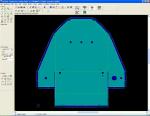What is CNC Punching?
Design considerations when CNC punching sheet metal fabrications
CNC punching is a manufacturing process that is carried out by CNC punch presses on sheet metal materials. These machines can be either a single head and tool rail (Trumpf) design or multi-tool turret design. The machine is basically programmed to move a sheet of metal in an x and y direction so as to accurately position the sheet under the machine’s ram ready to punch a hole. The processing range for most CNC punch presses is 0.5mm to 6.0mm thick in a range of sheet metal materials including steel, stainless steel and aluminium. The choice of hole punched can be as simple as a circle or rectangle through to special shapes to suit a specific sheet metal design. By using a combination of single hits and overlapping geometries, complex can be produced. The machine may also punch 3D forms such as dimples, taptite screw thread plunges, electrical knockouts and earth tags which are often employed in sheet metal enclosure designs. Some modern sheet metal punch press machines may have the ability to tap threads, fold small tabs, punch sheared edges without any tool witness marks making the machine very productive within the component cycle time. The instruction to drive the machine to create the desired component geometry is known as the CNC program.
CNC Programming

CNC programming is the computer aided manufacturing (CAM) side of the CAD/CAM cycle. Information about a design may be presented in a 2D format such as DXF or DWG files or a 3D file format. This information is then used to create the flat sheet metal pressing and assign the correct tooling to create the desired component. The software can also be used to establish the most efficient layout of components from a given size of sheet metal, known as the nest. Obviously, the more components that can be produced from a panel of sheet metal the cheaper each CNC punched component will become. Modern software packages such as Radan can help to automate this process to achieve the maximum yield from a given sheet metal panel. As a designer of components that will be CNC punched, you do not need to know the exact details of how this may be achieved but it may be useful to bare the following in mind when designing a component that is to be CNC punched from sheet metal.
Design considerations to remember when designing for CNC Punching of sheet metal
Diameters should ideally be no smaller than the material gauge of sheet metal being CNC punched.
Plunges with tapped holes can save money when replacing threaded inserts.
Cluster tools can be used to reduce CNC punching time for multiple holes and save money on repeated batches of sheet metal work.
Engraving tools can be used to identify parts e.g. part names, issue levels, customer or product names on your sheet metal components.
A CNC punched line of holes or slots can be used to create an ‘easy bend’ feature. This feature can help save space in your stores if a sheet metal fabrication can be supplied as a ‘flat pack’ design.
Earth tags can be CNC punched enabling your sheet metal design to have an easy earth point if needed.
‘Toy tags’ can be used to aid the assembly of small light weight parts instead of screws. These features are useful when designing reflectors for light fittings.
There are many other design considerations when it comes to CNC punching, feel free to call us for a chat on your next sheet metal project.